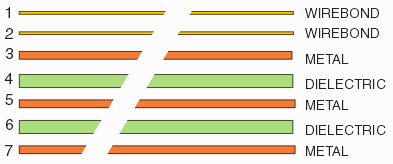Stackup
In order to run NETEX you must define a stackup in the - how the various layers are stacked together to form
a multi-layer board.

The stackup can be thought of as a table that defines:
- gerber file for that layer
- thickness
- type (metal, dielectric, wire)
- electrical properties
There are four kinds of layers:
Metal - this is a conductor layer that carries signals or power. You must specify a Gerber file for each metal layer in your stackup.
Dielectric - this is a layer that separates two conductor layers (or it may be on top of a conductor layer.) A dielectric layer has no Gerber file associated with it.
Wire - this is a special group of layers reserved for defining bond wires. It is treated differently than metal layers. Since the wires are in free space we don't do any booleans -- just use the wire endpoints and pass the information to the output ASCII file. Wires on a common layer may not cross in the X-Y plane so one may require multiple wire layers. No dielectric is needed between wire layers.
Information about the layer stackup is entered from NETEX-G's main menu
| 

